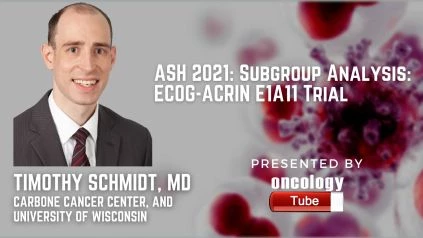Dr. Timothy Schmidt from the Carbone Cancer Center, and the University of Wisconsin, is a faculty member of the Division of Hematology, Medical Oncology, and Palliative Care within the Department of Medicine. He is a member of the American Society of Hematology, the American Society of Clinical Oncology, and the International Myeloma Society. Dr. Schmidt also serves as a peer reviewer for clinical hematology journals and is involved in medical education for trainees, medical professionals, and patient outreach organizations. In this video Dr. Schmidt speaks about the ASH 2021 Abstract – 467 Impact of Chromosome 1 Abnormalities Among Patients with Newly Diagnosed Multiple Myeloma: A Subgroup Analysis from the Endurance (ECOG-ACRIN E1A11) Trial.
Link to Abstract:
https://ash.confex.com/ash/2021/webprogram/Paper148907.html
Background:
In multiple myeloma (MM), extra copies of chromosome 1’s long arm (+1q) and deletion of its short arm (del1p) are associated with high risk characteristics, however the prognostic significance of +1q and/or del1p among patients with conventionally defined standard risk cytogenetics is unknown. It’s also unclear whether carfilzomib (K) in conjunction with lenalidomide (R) and dexamethasone (d) is more effective than bortezomib (V) in patients with chromosome 1 abnormalities (C1A).
Methods:
In the E1A11 experiment, patients without del17p, t(14;16), t(14;20), elevated LDH, or plasma cell leukemia who were not candidates for upfront transplant were randomized to undergo KRd versus VRd induction, followed by indefinite or 2-year R maintenance. Copy number (CN) was determined in pts with +1q, with gain1q defined as 3 copies and amplification (amp1q) defined as 4 copies of 1q. UHR MM was characterized as having two of the following: +1q, del1p, and t(4;14), with only one of these being a single hit (SH).
Results:
At the time of diagnosis, 912 patients were tested for +1q, with 310 (34%) having +1q. CN was known for 280 points, with 212 (76%) having gain1q and 68 (24%) having amp1q. There were no variations in treatment arm assignment or demographics between patients with +1q and those without, or by CN. Pts with +1q were more likely than those without +1q to have ISS Stage 3, hemoglobin 10g/dL, aberrant karyotype, del(1p), -13, t(4;14), and absence of t(4;14) (11;14). Del1p was tested in 774 patients and found in 69 (8.9%) of them at the time of diagnosis. ISS Stage 3, ECOG performance status >0, +1q, and the absence of t were more common in patients with del1p (11;14).
PFS had a median follow-up of 30.1 months (mo) and OS had a median follow-up of 41.3 months (mo). As illustrated in Figure 1, patients with +1q had significantly lower progression-free survival (median 29.1mo vs 41.9mo, HR 1.54, p0.001) and overall survival (OS) (3y OS 78.4 percent vs 86.9 percent, HR 1.38, p=0.035) than patients without +1q. There was no significant difference in PFS (median PFS 24.4mo vs 29.2mo, HR 1.24, p=0.275) or OS (3y-OS 68.9% vs 80.7 percent, HR 1.36, p=0.259) between patients with amp1q and gain1q. Pts with del1p had significantly worse PFS (median 28.8mo vs 38.6mo, HR = 1.49, p=0.042) and OS (3y OS 74.1 percent vs 85 percent, HR 2.03, p=0.003) than those without the mutation. Adding more “hits” resulted in poorer results. Pts without +1q, del1p, or t(4;14) had a median PFS of 47.9 months, 32.6 months, and 19.7 months, respectively, compared to pts with SH or UHR (SH HR 1.41, p=0.014; UHR HR 2.42, p0.001), and 3y OS rates of 89.2 percent, 79.5 percent, and 68.6 percent, respectively (SH HR 1.66, p=0.0
The induction arm’s outcomes were also assessed. Pts with and without +1q, as well as those with and without del1p, had identical best responses to VRd and KRd. PFS was significantly worse in both arms (VRd HR 1.51, p=0.011; KRd HR 1.63, p=0.002), and there was a tendency toward worse OS in both arms (VRd HR 1.47, p=0.069; KRd HR 1.34, p=0.185). In all arms, gain1q patients had a worse PFS (VRd HR 1.59, p=0.012; KRd HR 1.41, p=0.051). The VRd arm had a lower OS rate (HR 1.78, p=0.014), but not the KRd arm (HR 1.02, p=0.93). Pts with amp1q, on the other hand, fared worse with KRd (PFS HR 2.37, p0.001; OS HR 2.43, p=0.008) but not with VRd (PFS HR 1.43, p=0.186; OS HR 1.29, p=0.48). Both the VRd (HR 1.49, p=0.173) and KRd arms (HR 1.52, p=0.118) had a similar impact on PFS for pts with del1p. Patients with del1p who received VRd had a shorter survival time (HR 3.3, p0.001), but those who received KRd had no difference in survival time (HR = 1.1, p=0.818). UHR had a similar negative impact on PFS compared to no-hit for VRd (HR 2.21, p=0.009) and KRd (HR 2.74, p0.001), but UHR was considerably more damaging to OS in the VRd arm (HR 5.24, p0.001) than KRd (HR 1.33, p=0.516).
Conclusions:
Gain1q, amp1q, and del1p are associated with a worse PFS in patients with otherwise normal risk factors who are treated with standard triplet induction treatments without undergoing an upfront transplant. KRd may overcome the unfavorable OS impact among pts with gain1q and del1p, but not among pts with amp1q, notwithstanding the constraints of a post hoc subgroup analysis and the need for extended follow-up. Patients with +1q and del1p should be considered to have a high risk of developing MM and should be enrolled in clinical trials that use novel ways to improve outcomes in high-risk patients.

